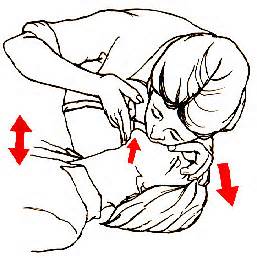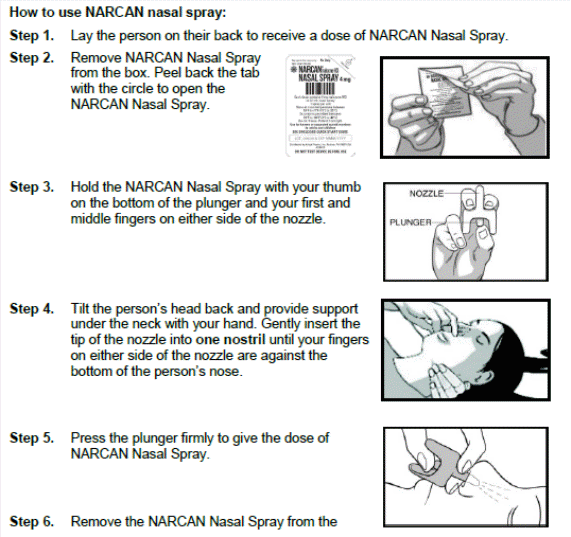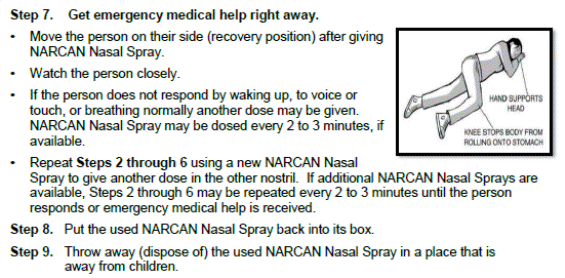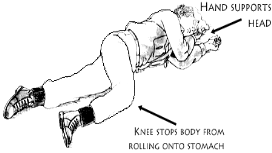K ENTUCKY DEPARTMENT FOR PUBLIC HEALTH CLINICAL PROTOCOL FOR
COUNTY EMERGENCY OPERATIONS PLAN COUNTY KENTUCKY EMERGENCY(KENTUCKY BANK LETTERHEAD) KRS 454185 TO MASTER COMMISSIONER OF
(REVISED JANUARY 2018) KENTUCKY OFFICE OF HIGHWAY SAFETY DIVISION
2013 KENTUCKY DIABETES FACT SHEET KENTUCKY DIABETES PREVENTION AND
20202021 KENTUCKY PRIDE FUND COMPOSTING GRANT APPLICATION PURPOSE TO
20212022 KENTUCKY PRIDE FUND RECYCLING GRANT APPLICATION PURPOSE TO
K ENTUCKY
DEPARTMENT FOR PUBLIC HEALTH
ENTUCKY
DEPARTMENT FOR PUBLIC HEALTH
CLINICAL PROTOCOL FOR INTRANASAL NALOXONE IN THE SCHOOL SETTING
Background
In 2015, SB 192, section 8, an amendment to KRS 217.186 (http://www.lrc.ky.gov/Statutes/statute.aspx?id=44004) made provisions for individuals with life-threatening symptoms of opioid overdose to have access to naloxone by the board of each local public school district and the governing body of each private or parochial school or school district that chooses to keep naloxone on the premises and regulate its administration. Changes to KRS 217.186 include:
A person or agency, including a school employee authorized to administer medication under KRS 156.502 may:
Receive a prescription for the drug naloxone;
Possess naloxone pursuant to this subsection and any equipment needed for its administration; and
Administer naloxone to an individual suffering from an apparent opiate-related overdose.
A person acting in good faith who administers naloxone received under KRS 217.186 shall be immune from criminal and civil liability for the administration, unless personal injury results from the gross negligence or willful or wanton misconduct of the person administering the drug.
Opioid overdose-related deaths can be prevented when naloxone is administered in a timely manner. As a narcotic antagonist, naloxone displaces opiates from receptor sites in the brain and reverses respiratory depression that usually is the cause of overdose deaths. During the period of time when an overdose can become fatal, respiratory depression can be reversed by giving the individual naloxone1. Naloxone should be administered promptly at the first sign of opioid overdoses. It is safer to administer naloxone than to delay treatment for opioid overdose.
Each school is encouraged to ensure ready access to naloxone and keep it in a minimum of two (2) locations in the school so that it may be administered to any individual believed to be having a life-threatening opioid overdose.
Schools electing to keep naloxone shall maintain the drug in a secure, accessible, but unlocked location. Naloxone may only be purchased with a prescription from a medical provider.
Each school electing to keep naloxone shall implement policies and procedures for managing opioid overdose, developed and approved by the local school board.
Administration of appropriate CPR measures may be needed if the individual does not have respirations or a heartbeat.
WHAT ARE OPIOIDS? 1
Opioids include illegal drugs such as heroin, as well as prescription medications used to treat pain such as morphine, codeine, methadone, oxycodone (OxyContin®, Percodan®, Percocet®), hydrocodone (Vicodin®, Lortab®, Norco®), fentanyl (Duragesic®, Fentora®), hydromorphone (Dilaudid®, Exalgo®), and buprenorphine (Subutex®, Suboxone®). Opioids work by binding to specific receptors in the brain, spinal cord and gastrointestinal tract. In doing so, they minimize the body’s perception of pain. However, stimulating the opioid receptors or “reward centers” in the brain also can trigger other systems of the body, such as those responsible for regulating mood, breathing and blood pressure.
HOW DOES OVERDOSE OCCUR?
A variety of effects can occur after a person takes opioids, ranging from pleasure to nausea, vomiting, severe allergic reactions (anaphylaxis) and overdose, in which breathing and heartbeat slow or even stop.1
Since the onset and severity of an opioid overdose is difficult to predict, the overdose may rapidly progress to respiratory depression. In some instances signs and symptoms of an opioid overdose may appear as an individual experiencing extreme sleepiness or having breathing difficulties. Naloxone should be administered promptly at the first sign of an opioid overdose.
WHO MAY BE AT RISK
The following clinical factors may increase a patient's risk for overdose when taking an opioid 1, 3–10
Anyone who uses opioids for long-term management of chronic cancer or non-cancer pain is at risk for opioid overdose
Substance abuse, dependence and/or addiction, as are persons who use heroin
Accidental exposure and unintentional opioid misuse
Includes members of a patient’s household who may discover and use the prescribed opioid inappropriately
A morphine-equivalent dose (MED) ≥20 mg per day
Switching to another opioid
Chronic pulmonary disease
Sleep apnea
Asthma
Chronic kidney and/or liver impairment
Use of CNS depressants, including benzodiazepines and alcohol
Use of certain medications for depression, including monoamine oxidase inhibitors (MAOIs)
SIGNS AND SYMPTOMS OF OPIOID OVERDOSE
All school staff, including those in extracurricular programs should be trained on how to recognize the signs and symptoms of an opioid overdose requiring the use of a naloxone. Symptoms of an opioid overdose requiring the use of naloxone may include but are not limited to the following: extreme sleepiness (inability to awaken verbally or upon sternal rub); breathing problems which can range from slow to shallow breathing in a patient that cannot be awakened; fingernails or lips turning blue/purple; extremely small “pinpoint” pupils; slow heartbeat and/or low blood pressure. Signs of overmedication which may progress to overdose include: unusual sleepiness; drowsiness; or difficulty staying awake despite loud verbal stimulus or vigorous sternal rub; mental confusion; slurred speech; intoxicated behavior; slow or shallow breathing; extremely small “pinpoint” pupils, although normal size pupils do not exclude opioid overdose; slow heartbeat; low blood pressure; and difficulty waking the person from sleep.1
It is important to note that not all signs and symptoms may be present during an opioid overdose. If the individual is not responsive to shaking, yelling or vigorously rubbing their sternum, ACT PROMPTLY!!
CALL FOR HELP!
CHECK FOR BREATHING!
CALL 911 IMMEDIATELY!
GET THE NALOXONE!
Differentiating between overdose and an opioid high
Sometimes it is difficult to tell if someone is overdosing or if they are just really high. The table below offers clues on how a responder might be able to tell the difference.4
|
REALLY HIGH |
OVERDOSE |
|
Muscles become relaxed |
Pale, clammy skin |
|
Speech is slowed/slurred |
Very infrequent or no breathing |
|
Sleepy looking |
Deep snoring or gurgling (death rattle) |
|
Responsive to stimuli (such as shaking, yelling, vigorous sternal rub, etc…) |
Not responsive to stimuli (such as shaking, yelling, vigorous sternal rub, etc…) |
|
Normal heart beat/pulse |
Slow heart beat/pulse |
|
Normal skin tone/color |
Blue lips and/ or fingertips |
Because opioids depress respiratory function and breathing, one telltale sign of a person in a critical medical state is the “death rattle.” If a person emits a “death rattle” an exhaled breath with a very distinct, labored sound coming from the throat, emergency resuscitation will be necessary immediately, as it almost always is a sign that the individual is near death1.
RESPONDING TO AN OPIOID OVERDOSE
IF YOU SUSPECT AN OVERDOSE
ACT PROMPTLY!! Always go a distressed individual. Never send the individual to the health room/school nurse alone or leave them alone. Do not move an individual who is in severe distress.
AN OPIOID OVERDOSE NEEDS IMMEDIATE MEDICAL ATTENTION. An essential step is to get someone with medical expertise to see the patient as soon as possible, CALL 911 immediately1 to activate emergency medical services (EMS).
CALL 911 immediately
If you suspect an opioid overdose or if someone is showing signs of respiratory distress (infrequent or no breathing, deep snoring or gurgling), call 911 or direct someone to call 911 to request immediate medical assistance. Advise the 911 operator that an opioid overdose is suspected and that naloxone has been given or is being given.
PROVIDE RESCUE BREATHING if necessary
For a person who is not breathing or who is unresponsive with shallow, infrequent breathing, rescue breathing is the quickest way to get oxygen to the brain and is an important step in preventing an overdose death.
Steps for rescue breathing are:
Place the person on his or her back and pinch their nose.
Open the person’s airway by tilting the chin up and gently pushing down on the forehead. Look into the mouth to see if there is anything blocking the airway. If so, remove it.
Create an air tight mouth to mouth seal on the victim’s mouth.
Take a regular (not deep) breath, and give a breath over 1 second.
Blow enough air into the lungs to make the chest rise. If the chest is not rising, tilt the head back more and try again.

Give a second rescue breath over 1 second.
Breathe again every 5 seconds until the patient is breathing on their own, or EMS arrive and take over.
ADMINISTER NALOXONE
There are multiple routes of administration for FDA approved naloxone: intramuscular, subcutaneous, intranasal and intravenous. Schools may choose to use administration methods that are more cost effective such as syringe/needle and naloxone vial method. For the purposes of this guidance, the use of the FDA approved intranasal naloxone will be reviewed.
Most patients respond by returning to spontaneous breathing, with minimal withdrawal symptoms. The response generally occurs within 3 to 5 minutes of naloxone administration. Rescue breathing should continue while waiting for the naloxone to take effect.1
Important: Intranasal naloxone is for use in the nose only.
• Do not remove or test the NARCAN Nasal Spray until ready to use.
• Each NARCAN Nasal Spray has 1 dose and cannot be reused.
• You do not need to prime NARCAN Nasal Spray.


Naloxone will continue to work for as long as 30 to 90 minutes, but after that time, overdose symptoms may return.1 ASSURE 911 HAS BEEN CALLED and that EMS was activated. If no one has yet called 911, IMMEDIATELY CALL 911.
4. DIRECT SOMEONE TO CALL AND NOTIFY THE FRONT OFFICE AND THE SCHOOL NURSE
If the individual is breathing on their own, place them in the recovery position.
After giving naloxone, stay with the individual. If they are breathing on their own, to decrease the individual’s chance of choking on their vomit, place them in the recovery position, on their side and support the body with one bent knee with the face turned to the side

5. STAY WITH THE PERSON AND MONITOR FOR RESPIRATORY DISTRESS. Provide rescue breathing as necessary. It is necessary to seek immediate emergency medical assistance (911) after delivering the first dose of naloxone, keep the patient under continued surveillance, and repeat doses of naloxone as necessary.
6. REPEAT NALONONE ADMINISTRATION IF SYMPTOMS CONTINUE.
The duration of action of most opioids is likely to exceed the 30-90 minutes that naloxone will be effective, resulting in a return of respiratory and/or central nervous system depression, even after an initial improvement in symptoms. If the desired response is not obtained after 2 or 3 minutes, another dose of naloxone may be administered if available.
If after 1-2 doses of naloxone there is no breathing or breathing continues to be shallow, lay the person on their back and continue to perform rescue breathing while waiting for the naloxone to take effect, they breathe for themselves or EMS arrives.
DOCUMENT the individual’s name, date, time and route the naloxone was administered and give this information to EMS, so that the information will accompany the individual to the hospital’s emergency department.
Document the incident and complete school incident report.
Replace naloxone in-stock medication as appropriate as soon as possible.
NALOXONE2
Generic Name: naloxone (nah LOX own) Brand Names: Narcan
INDICATIONS AND USAGE2
Naloxone is an opioid antagonist indicated for the emergency treatment of known or suspected opioid overdose, as manifested by respiratory and/or central nervous system depression. Naloxone is intended for immediate administration as emergency therapy in settings where opioids may be present. Naloxone is not a substitute for emergency medical care. When in doubt, if an individual is unresponsive and an opioid overdose is suspected, administer naloxone as quickly as possible because prolonged respiratory depression may result in damage to the central nervous system or death. Call 911 to activate EMS immediately after administering the first dose of naloxone.
HOW NALOXONE IS SUPPLIED2
Intranasal naloxone is supplied in a carton containing two blister packages each with a single NARCAN Nasal Spray (single 4 mg dose of naloxone hydrochloride intranasal spray).
For questions regarding dosage or timing of the brand being used, please see product package insert instructions developed by the manufacturer.
STORAGE AND HANDLING OF INTRANASAL NALOXONE
Store NARCAN Nasal Spray in the blister and cartons provided in a controlled room temperature 15°C to 25°C (59°F to 77°F) and in a dry, dark area.
The naloxone should be checked monthly to ensure proper storage, expiration date, and medication stability.
Personnel should be familiar with the type of naloxone maintained by the school and its use.
Schools should refer to the package insert and store naloxone hydrochloride according to the individual manufacturer’s direction.
RESPONDING TO AN OPIOID OVERDOSE WITH NALOXONE FLOW CHART 4
The following flow-chart illustrates the steps that are taken depending on the victim’s responsiveness.






 Responsive
Not Responsive
Responsive
Not Responsive





 Responsive
Not
Responsive
Responsive
Not
Responsive





 Breathing
Not
Breathing
Breathing
Not
Breathing
















 Breathing Not
Breathing
Breathing Not
Breathing




REFERENCES AND SOURCES
http://store.samhsa.gov/shin/content//SMA14-4742/Overdose_Toolkit.pdf
http://www.narcannasalspray.com/ Intranasal Naloxone FDA Package Insert:
Massachusetts Department for Public Health Opioid Overdose Education and Naloxone Distribution, http://www.mass.gov/eohhs/docs/dph/substance-abuse/core-competencies-for-naloxone-pilot-participants.pdf.
Bohnert ASB, Valenstein M, Bair MJ, et al. Association between opioid prescribing patterns and opioid overdose-related deaths. JAMA. 2011;305(13):1315–1321.
Duragesic® (fentanyl transdermal system) [prescribing information]. Titusville, NJ: Janssen Pharmaceuticals, Inc: 2013.
Percocet® (oxycodone hydrochloride and acetaminophen tablets) [prescribing information]. Malvern, PA: Endo Pharmaceuticals Inc; 2013.
Opana® (oxymorphone hydrochloride tablet) [prescribing information]. Malvern, PA: Endo Pharmaceuticals Inc; 2013.
Burghardt LC, Ayers JW, Brownstein JS, et al. Adult prescription drug use and pediatric medication exposures and poisonings. Pediatrics. 2013;132(1):18–27.
Data on file. kaleo, Inc.
Madadi P, Hildebrandt D, Lauwers AE, Koren G. Characteristics of opioid-users whose death was related to opioid-toxicity: a population-based study in Ontario, Canada. PLoS One. 2013;8(4):e60600. doi: 10.1371/ journal.pone.0060600. Epub 2013 Apr 5.
Green TC, Grau LE, Carver HW, Kinzly M, Heimer R. Epidemiologic trends and geographic patterns of fatal opioid intoxications in Connecticut, USA: 1997–2007. Drug Alcohol Depend. 2011;115(3):221–228.
Additional Resources
National Association for School Nurses (NASN) Medication Administration in the School Setting:http://www.nasn.org/PolicyAdvocacy/PositionPapersandReports/NASNPositionStatementsFullView/tabid/462/smid/824/ArticleID/86/Default.aspx
Substance Abuse and Mental Health Services Administration. Opioid overdose toolkit: information for prescribers. Accessed April 29, 2015.
http://store.samhsa.gov/shin/content//SMA14-4742/Overdose_Toolkit.pdf
http://www.fda.gov/NewsEvents/Newsroom/PressAnnouncements/ucm391465.htm
We
would like to acknowledge and thank the Massachusetts Department
for Public Health for the use of any information from the
Massachusetts
Department for Public Health Opioid Overdose Education and Naloxone
Distribution, in
developing these protocols.
Core Clinical Service Guide
Appendix B – Intranasal Naloxone In The School Setting
July 1, 2016
702 KAR 4160 KENTUCKY DEPARTMENT OF EDUCATION REQUEST FOR
89 RECORD OF BOARD PROCEEDINGS (MINUTES) LUDLOW KENTUCKY MARCH
AMAZING AXOLOTLS! UNIVERSITY OF KENTUCKY AMBYSTOMA GENETIC STOCK
Tags: clinical protocol, core clinical, entucky, clinical, department, protocol, public, health
- KLEBSTOFFE IN DER KRIMINALISTIK VERBRECHERJAGD MIT SEKUNDENKLEBER GESCHIEHT EIN
- ESSENTIAL RECORDS WEBINAR DETERMINE ESSENTIAL FUNCTIONS AND SESSION 1
- CPP SEMINARS SCOTLAND CONNECTING POLICY TO PRACTICE A ½
- BROWNIE 4 TAZAS DE HARINA 2 TAZAS DE AZUCAR
- EFFECTS OF SPECULATION AND INTEREST RATES IN A “CARRY
- STAI20041 POWERPLUSWATERMARKOBJECT23706054 (ABOLISHED AND REPLACED BY STAI20167 ISSUED ON
- LIBRETA PRECIO 1 2 3 4 5 6
- CHAPTER 12 SIGNIFICANCE TESTS IN PRACTICE 121 TESTS ABOUT
- NACHO SANCHEZ
- 1 CATEGORICAL CONTRAST AND AUDIENCE APPEAL NICHE WIDTH AND
- MERKBLATT ÜBER DIE MÖGLICHEN FOLGEN EINER BEFREIUNG VON DER
- SAW ACADEMY FOR TEACHING EXCELLENCE SAW EVIDENCE TO EXCELLENCE
- TČ 12 PRILOGA INVESTICIJSKI PROGRAM ŠT 42007 REKONSTRUKCIJA JAVNE
- 18 ELECTRONIC SUPPLEMENT NEGOTIATED INTERACTION IN THE L2 CLASSROOM
- ENTRE LES MURS – THE CLASS 1 WHAT SIMILARITIES
- PROJETO PARADAS SONORAS O PROJETO PARADAS SONORAS A PARTIR
- 1 PARTES DE LA GRAMÁTICA UNIDADES FUNDAMENTALES DEL ANÁLISIS
- BUYER AGENCY AGREEMENT BROKER ROYAL LEPAGE PRIME
- MODEL OF 2 LAYER SEDIMENT CAP DESCRIPTION AND PARAMETERS
- PREVERJANJE ZNANJA – APJ 3 (VSE SKUPAJ 10 TOČK)
- NUMERICAL TOOLBOX FOR PRICING BINOMIAL TRINOMIAL TREES FINITE DIFFERENCE
- CHECK LISTS FOR THE 12 UNIVERSAL
- ENGLISH SAILING TRAWLERS SMACKS (1ST CLASS) COMPILED BY
- REKENEN BREUKEN ANTWOORDEN KLEUR HET JUISTE DEEL (MET
- NATALIA GRIAKALOVA “BOI V LUBKE” NOTES FOR INTERPRETATION OF
- KWALIFIKOWANA PIERWSZA POMOC I ROK DIETETYKA – LICENCJAT DZIENNY
- PRIJAVNI OBRAZEC 3 ZA DODELITEV POMOČI ZA OHRANJANJE IN
- SAMPLE SIZE REQUIREMENTS FOR THE INTERNAL VALIDATION OF PSYCHIATRIC
- EL GALLO QUE NO PODÍA CANTAR COMO CADA MAÑANA
- UNIVERSIDAD DE ESPECIALIDADES ESPÍRITU SANTO FACULTAD DE SYLLABUS VERSIÓN
 PROJEKT RECHTSINFORMATIONSSTELLE DIGITALE HOCHSCHULE NRW LEITUNG PROF THOMAS HOEREN
PROJEKT RECHTSINFORMATIONSSTELLE DIGITALE HOCHSCHULE NRW LEITUNG PROF THOMAS HOEREN 2 CROMATOGRAFÍA PRINCIPIOS GENERALES TEMA 2 CROMATOGRAFÍA PRINCIPIOS GENERALES
2 CROMATOGRAFÍA PRINCIPIOS GENERALES TEMA 2 CROMATOGRAFÍA PRINCIPIOS GENERALESUNIVRZITET U BEOGRADU UCITELJSKI FAKULTET PISANA PRIPREMA ZA ISPITNI
 ANEXO I MODELO DE OFERTA ECONÓMICA ………………………………………………………………………………… (NOMBRE Y
ANEXO I MODELO DE OFERTA ECONÓMICA ………………………………………………………………………………… (NOMBRE YOOE POLICY 46 ATTACHMENT 1 (REV 82019) SCHOOL FIRE
TOPICS FOR WRITING 2º BACHILLERATO 1 “THERE SHOULD
JUNTA DE EXTREMADURA CONSEJERÍA DE EDUCACIÓN DIRECCIÓN GENERAL
 UNIVERSIDADE DO ESTADO DO RIO DE JANEIRO INSTITUTO DE
UNIVERSIDADE DO ESTADO DO RIO DE JANEIRO INSTITUTO DE DETERMINING CONVERGENT EVOLUTION WITH AMINO ACID SEQUENCES OF HEMOGLOBIN
DETERMINING CONVERGENT EVOLUTION WITH AMINO ACID SEQUENCES OF HEMOGLOBIN Collaboration Agreement Entered Into by Aragón Fundacion iis Aragon
Collaboration Agreement Entered Into by Aragón Fundacion iis Aragon PARLAMENTUL ROMÂNIEI LEGE NR 1952001 DIN 20042001 VERSIUNE ACTUALIZATA
PARLAMENTUL ROMÂNIEI LEGE NR 1952001 DIN 20042001 VERSIUNE ACTUALIZATACERTIFICADO DE ACTA DE ELECCIÓN O MODIFICACIÓN DE LOS
PLNÁ MOC JÁ …………………………………………………… NAR …………………… DÁVÁM PLNOU MOC
 MINIQUIZ NOTE POUR FINS DE RÉFÉRENCES CE QUESTIONNAIRE
MINIQUIZ NOTE POUR FINS DE RÉFÉRENCES CE QUESTIONNAIRE W WWESCUELAPRIMARIANET CUARTO DE PRIMARIA LOS MAMÍFEROS CONSTITUYEN UNA
W WWESCUELAPRIMARIANET CUARTO DE PRIMARIA LOS MAMÍFEROS CONSTITUYEN UNA INTRODUKSJON TIL PERSONVERN I ARBEIDSFORHOLD MED FORSLAG TIL RUTINER
INTRODUKSJON TIL PERSONVERN I ARBEIDSFORHOLD MED FORSLAG TIL RUTINEREL GALLITO ROJO CUENTO DE IRLANDA UN GATO UN
 TEMA 9 VARIABLES ALEATORIAS ● UNA VARIABLE ALEATORIA ES
TEMA 9 VARIABLES ALEATORIAS ● UNA VARIABLE ALEATORIA ESREAL DECRETO 582005 DE 21 DE ENERO POR EL
MEMBERSHIP PROGRAMS DUCKS UNLIMITED CONTRIBUTORS ARE CLASSIFIED IN THE